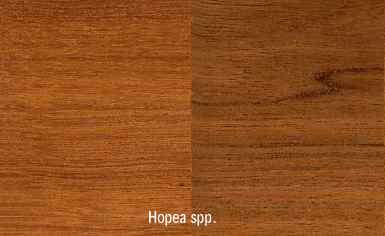
Balau (Hopea papuana)
Family: Dipterocarpaceae
Common names: Balau, Ehang besi, Gagil, Giam, Gisok-gisok, Gointa, Hopea, Kaliot, Keilmen ogerie, Koha pilopilo, Koka-pilo-pilo, Lao-two, Light hopea, Linakiong, Magasusu, Manggachapui, Matajien, Matre, Merawan, Narek, Pasang keserup, Riheu, Sangal, Tjengal
Distributed in: Indonesia, Papua New Guinea (Oceania and S.E. Asia)
Common uses: Agricultural implements, Boat building (general), Bridge construction, Cabinetmaking, Decks, Flooring, Flooring: industrial heavy traffic, Furniture, Handles: general, Heavy construction, Joinery (external): ground contact, Joinery, Ladders, Light construction, Marine construction, Mine timbers, Paneling, Piling, Railroad ties, Turnery, Vehicle parts
Environment profile: Vulnerable
Tree size: Trunk diameter is 200-250 cm
Colors: the heart isYellow, Yellow to golden-yellow to orangeand the sapwoodWhite to yellow, Yellow.The grain isVariable figure, the textureMediumand the lusterMedium
Natural durability: Susceptible to insect attack, Very durable
LightInduced Color Change: Darker
Kiln Schedules: UK=E US=T6D2/T3D1 Fr=5
Kiln Drying Rate: Naturally dries slowly
Drying Defects: Slight twist/warp, Splitting
Ease of Drying: Slowly
Tree Identification: Bole/stem form is buttressed
Blunting Effect: Moderate
Boring: Fairly easy to very easy
Carving: Fairly Difficult to Very Difficult
Cutting Resistance: Fairly Difficult to Very Difficult to saw
Gluing: Moderate gluing properties
Mortising: Very Good to Excellent
Moulding: Very Good to Excellent
Movement in Service: Very Good to Excellent
Nailing: Poor to Very Poor , Pre-Boring Recommended
Planing: Very Good to Excellent
Resistance to Impregnation: Resistant sapwood
Response to hand tools: Responds Poorly
Routing recessing: Fairly Difficult to Very Difficult
Sanding: Very Good to Excellent Results
Veneering qualities: Veneers easily, Veneers moderately easy
Steam bending: Very Good to Excellent Results
Screwing: Fairly Difficult to Very Difficult, Pre-boring recommended; Turning: Very Good to Excellent Results
Painting: Fair to Good; Polishing: Very Good to Excellent; Staining: Finish is generally satisfactory; Varnishing: Very Good to Excellent;
- Numerical data Metric
- Numerical data English
- Strength properties
- References
 |
 |
 |
 |
| Item |
Green |
Dry |
Metric |
| Specific Gravity |
|
|
|
| Density |
|
689 |
kg/m3 |
| Bending Strength |
834 |
1293 |
kg/cm2 |
| Crushing Strength |
485 |
699 |
kg/cm2 |
| Hardness |
|
451 |
kg |
| Impact Strength |
|
|
cm |
| Shearing Strength |
|
139 |
kg/cm2 |
| Stiffness |
152 |
175 |
1000 kg/cm2 |
| Tangential Shrinkage |
|
|
% |
| Radial Shrinkage |
2 |
|
% |
| Weight |
673 |
544 |
kg/m3 |
| Maximum Load |
|
|
cm-kg/cm3 |
| Toughness |
|
|
cm-kg |
| Static Bending |
|
|
kg/cm2 |
|
 |  |  |  | | Item | Green | Dry | English | | Bending Strength | 11870 | 18400 | psi | | Density | | 43 | lbs/ft3 | | Hardness | | 995 | lbs | | Maximum Crushing Strength | 6899 | 9945 | psi | | Shearing Strength | | 1989 | psi | | Stiffness | 2167 | 2494 | 1000 psi | | Weight | 42 | 34 | lbs/ft3 | | Radial Shrinkage | 2 | | % | | Tangential Shrinkage | 9 | | % | |
Density (dry weight) = 38-45 lbs/cu. ft. 0
Density (dry weight) = 46-52 lbs/cu. ft.
Modulus of Elasticity (stiffness) = high
Max. crushing strength = high
Bending strength (MOR) = high
Shrinkage, Tangential = fairly large
Shrinkage, Radial = very small
Shearing strength (parallel to grain) = medium
Hardness (side grain) = soft
Density (dry weight) = 53-60 lbs/cu. ft.
Bending strength (MOR) = medium
Shearing strength (parallel to grain) = low
Bolza, E., Kloot, N.H.,1976,The Mechanical Properties of 81 New Guinea Timbers,C.S.I.R.O. Div. Building Res. Tec.Paper (2nd series) 11Bolza, E.,1975,Properties and Uses of 175 Timber Species from Papua New Guinea and West,Irian,C.S.I.R.O. Div. Building Research Report,no.34Brown, W.H.,1978,Timbers of the World, No. 8 Australasia,TRADA, Red Booklet SeriesEddowes, P.J.,1977,Commercial Timbers of Papua New Guinea: Their Properties and Uses,Hebano Press, Port Moresby, Papua New GuineaFundter, J.M.,1982,Names for Dipterocarp timbers and trees from Asia,Pudoc, Wageningen, NetherlandsKeating, W.G., Bolza, E.,1982,Characteristics properties and uses of timbers. South East Asia, Northern,Australia and the Pacific,C.S.I.R.O. Div. Chemical Technology,Inkata Press,1Kraemer, J.H.,1951,Trees of the Western Pacific Region,West Lafayette, Indiana U.S.A.Papua New Guinea Department of Forests,1972,New Horizons,Forestry in Papua New Guinea,Jacaranda Press PTY Ltd, BrisbanePapua New Guinea,1982,Papua New Guinea timbers - technical data,Forest Industries Council P.N.G.
|








